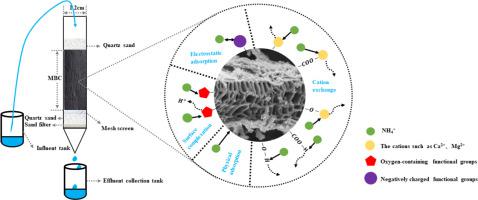Journal of Water Process Engineering ( IF 6.3 ) Pub Date : 2021-07-27 , DOI: 10.1016/j.jwpe.2021.102219 Qiang An 1, 2 , Zheng Li 2 , Ying Zhou 2 , Fanyu Meng 2 , Bin Zhao 2 , Yue Miao 2 , Shuman Deng 2

|
Ammonium pollution caused by human activities threated to eco-environment and the groundwater was polluted by rain and other leaching processes. This study investigated the mechanism and dynamic adsorptive characteristic of ammonium (NH4+-N), which removed by a novel modified biochar (MBC) pyrolyzed from peanut shell. The maximum capacity of unmodified biochar (BC) and modified biochar (MBC) to ammonium absorption could reach 3.83 mg/g and 6.92 mg/g, respectively, indicating that modification would enhance the performance of the adsorbent. Analyzing a batch of experimental data, it can be found that the isothermal absorption was suitable for Sips model and the kinetic adsorption model suitable for quasi-second-order kinetic model, indicating that the adsorptive rate was related to the amount of the adsorption site and dominated by monolayers chemisorption. The characteristics of MBC before and after the process of adsorption showed that ion exchange, electrostatic adsorption and surface complexation were the main factors controlling adsorptive capacity. The dynamic removal performance of ammonium by MBC under different conditions was investigated by column experiments. The experimental data of breakthrough curve fitted the Thomas model well. The maximum adsorptive capacity (kTH = 5.28 × 10–3 L/(mg·h), and qe = 9.02 mg/g) was obtained when the influent concentration reached 30 mg/L, the bed depth 2.1 cm and the inflow rate 1 mL/min. It can be concluded that the MBC was a promising adsorbent which can effectively remove ammonium from groundwater.
中文翻译:

花生壳基改性生物炭去除地下水氨:机理分析和柱实验
人类活动造成的氨污染威胁着生态环境,地下水受到雨水和其他浸出过程的污染。本研究研究了铵(NH 4 +-N),由花生壳热解的新型改性生物炭 (MBC) 去除。未改性生物炭 (BC) 和改性生物炭 (MBC) 对铵吸收的最大容量分别达到 3.83 mg/g 和 6.92 mg/g,表明改性将提高吸附剂的性能。对一批实验数据进行分析,可以发现等温吸附适用于Sips模型,而动力学吸附模型适用于准二级动力学模型,说明吸附速率与吸附位点的数量和吸附量有关。以单层化学吸附为主。MBC吸附前后的特性表明,离子交换、静电吸附和表面络合是控制吸附容量的主要因素。通过柱实验研究了MBC在不同条件下对铵的动态去除性能。突破曲线的实验数据符合Thomas模型。最大吸附容量(kTH = 5.28 × 10–3 L/(mg·h), q e = 9.02 mg/g) 当进水浓度达到 30 mg/L,床深 2.1 cm 和进水速度 1 mL/min 时得到。可以得出结论,MBC是一种很有前途的吸附剂,可以有效地去除地下水中的铵。











































 京公网安备 11010802027423号
京公网安备 11010802027423号